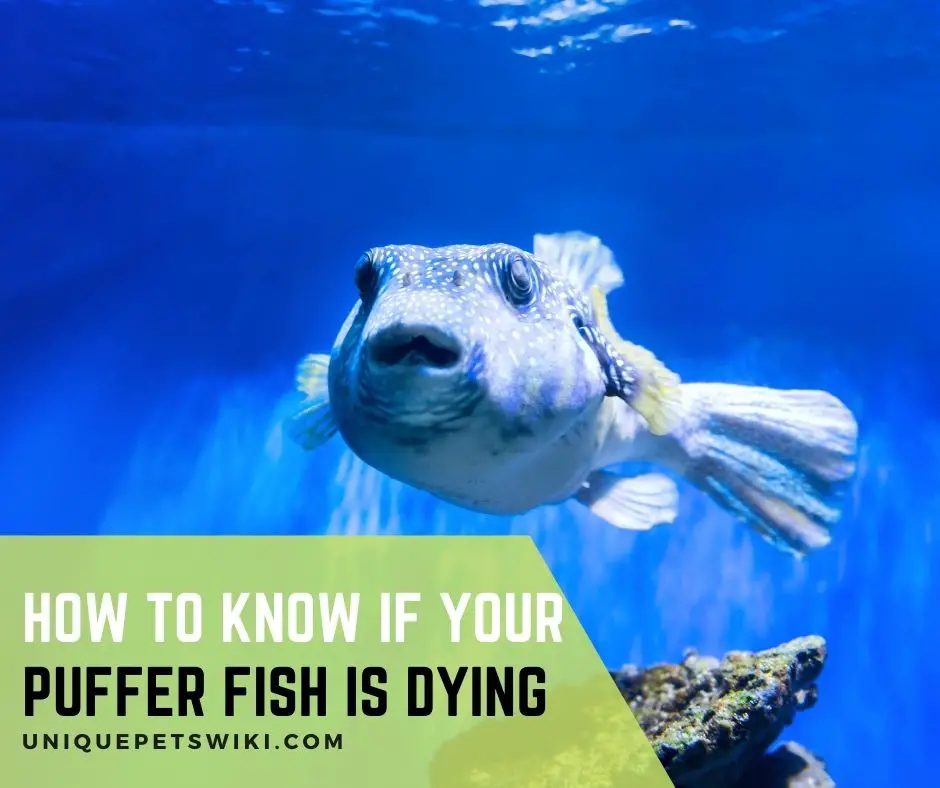The first sign to help determine that a pufferfish is dying is when it rejects its food. Some of the other signs of a dying pufferfish are white spots, gasping at the surface, rapid breathing, clamped fins, itching against the tank accessories, etc.
Pufferfish are adorable fish species commonly found in marine and brackish water species but can also be found in freshwater.
They are popularly known for swelling up whenever they are threatened to avoid being eaten. Pufferfish are hardy creatures but can die if you don’t provide them with the ideal environment.
As a beginner hobbyist, you may be frustrated that your pufferfish keeps dying and wondering what the signs of a dying fish are to help prevent this from happening in the future.
This article helps highlight everything you need to know when your pufferfish is dying from the common signs to the ideal treatment.
Contents
9 Pufferfish Dying Signs
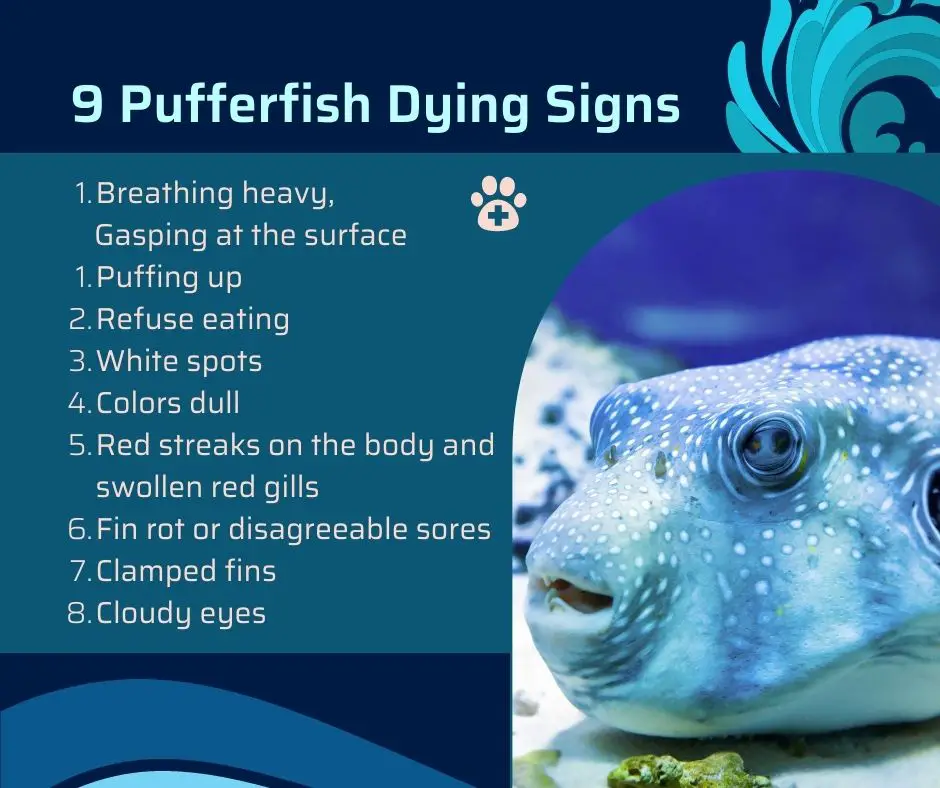
Like most fish species, pufferfish can suffer from a wide range of health problems that you should keep an eye on.
Generally, pufferfish are an active species, and if you notice that your fish is not as active as normal, it may indicate that it is suffering from a health problem.
Some of the other signs that may indicate that a pufferfish is dying are stated below.
- Your fish is breathing heavily
- Puffing Up
- Loss of pigmentation
- Sunken or cloudy eyes
- Your puffer fish puffs frequently
- Lack of appetite
- Your pufferfish floats lethargically or hides always
- Your fish has swollen gills
- White spots on their body
- Cloudy eyes
- Fin rots
Breathing Heavy, Gasping At The Surface
A pufferfish breathing heavily or gasping at the water’s surface for air is one of the top signs that it is dying. You will notice as your pufferfish hangs just below the water surface while gasping for air.
This usually happens if your pufferfish is poisoned, the oxygen level in their tank is too low, their fluke gills, have high nitrate levels, or the tank is holding too much water.
Once you notice these symptoms the first thing to do is to test the water parameter (ammonia, pH, nitrite, etc.).
You can then use Melafix for about a week if you notice that the nitrate is above 20ppm. You should also change the water and aerate the tank with an air pump if the oxygen level is low.
However, you would need to take your puffer to a specialist if this happens because some parasites affect their gills.
Melafix Liquid Remedy 16oz.
- Country Of Origin: United States
Last update on 2022-12-29 / Affiliate links / Images from Amazon Product Advertising API
Puffing Up
Although pufferfish are known to puff up when threatened, puffing is usually stressful and can damage their organs.
Pufferfish do not puff up unless it is necessary. When a puffer fish puffs up, they increase in size, but their organs move to the side of their body and then flatten.
There are cases where pufferfish can die from puffing as the air gets trapped in them. However, if your pufferfish puffs frequently it may indicate that it has a health issue.
The common cause for puffing in pufferfish is extreme fear and stress. You can prevent this by ensuring their tank is at optimal water conditions. Furthermore, you need to ensure you don’t overcrowd your pufferfish in a tank.
Refuse Eating
Generally, pufferfish are voracious eaters, and they take lots of food happily. Therefore, you should be very worried if your axolotl is not taking food for days.
This usually indicates that it is dying as they can only go for about 5-7 days without food.
Furthermore, lack of nutrients in their body can lead to bacteria build up in their body. Some of the reasons why a pufferfish can stop eating are:
- Bad water quality
- Your pufferfish is constipated
- The pufferfish is infested by an internal parasite
- Poor quality foods
The first thing to do when a pufferfish stops eating is to check the water quality and you should try to get the water back to the ideal level.
You should also be on the lookout for signs of constipation. Another thing to do is to try and encourage your puffer to eat by feeding them with small snails, bloodworms, or blackworms.
Note: a new pufferfish may need a few days to adjust to its new environment before it starts eating.
Hikari Usa AHK73254 Prazipro for Aquarium, 4-Ounce
- Hikari prazipro 4oz
- For disease conditions caused by flukes, tapeworm, flatworm and turbellarians
- Oxybispropanol and <5percentage praziquantel by weight
Last update on 2022-12-30 / Affiliate links / Images from Amazon Product Advertising API
White Spots
White spots are an indication that your pufferfish is suffering from white spot disease known as ich. You may find white spots covering your pufferfish body.
You can also notice that your puffer is scraping its body against the objects in the tank-like rocks.
This usually occurs if your pufferfish is infested by parasites or build-up of chemicals in their tank. You can treat this health problem using formalin, acriflavine, malachite green, or copper sulfate.
Another way to treat this is by adding 1 tablespoon of salt per 5 gallons of the aquarium while raising the water temperature gradually to 86F.
A great way to avoid ich is to quarantine new fish in a separate tank before introducing them to their tank.
Colors Dull
You can also detect whether your pufferfish is dying if it has faded colors or white bodies. Your pufferfish can lose their vibrant color if there is a lack of oxygen plus loss of nutrients and absence of sunlight.
Pufferfish can also lose their color if there is a buildup of ammonia and nitrite in their tank.
This can then make them have difficulty breathing. Some of the other signs to be on the lookout for are:
- Lethargy
- Erratic swimming
- Loss of appetite
- Hiding frequently.
It is best to do a water test immediately when you notice this sign. You can then do a 25% water change and siphon out waste from their water to help reduce the ammonia and nitrite levels.
You can also invest in an air pump if your pufferfish is suffering from a lack of oxygen.
Red Streaks On The Body And Swollen Red Gills
Red streaks on pufferfish bodies and swollen red gills are usually a bacteria infection symptoms.
It is possible for bacteria to enter the circulatory system of your fish and then travel around its body, leading to damage to their blood vessels, body tissues, and heart.
Pufferfish can get infected by bacteria if there are wounds on their skin, bitten by additional fish, or an ammonia spike in their enclosure.
Apart from swollen red gills, some of the other signs to help indicate that bacteria infect pufferfish are:
- Open sores on their body
- Distended abdomen
- Hemorrhaging of the skin and inner organs
- Bulging eyes
- Lethargy
Once you notice this sign, immediately isolate the sick fish from their tank and add antibiotics like chloromycetin or tetracycline to their food.
You should also treat the aquarium with a disinfectant before adding the fish again.
The best way to prevent bacterial infection in pufferfish is to maintain good water quality in their tank.
Fin Rot or Disagreeable Sores
Pufferfish suffer from health problems if their fin is rotting or if there is sores on their body.
Fin rot in pufferfish is a health condition caused by bacteria. This occurs if you don’t take proper care of your pufferfish, house them in a dirty tank, or expose a pufferfish to fish with an infectious disease.
Some of the signs to be on the lookout for if your pufferfish is suffering from fin rots are:
- The fin color may fade
- Liberal deterioration of their tails or fins
- The fin looks torn and ragged, like they are rotting away
- Your pufferfish has a rough and white fin
You can treat fin rot in pufferfish by isolating the affected fish and then giving it a broad-spectrum antibiotic like erythromycin.
You will also need to check the water quality of their tank and ensure the pH and ammonia are at an ideal level.
API Water Test Kit
- Contains one (1) API FRESHWATER MASTER TEST KIT 800-Test Freshwater Aquarium Water Master Test Kit, including 7 bottles of testing solutions, 1 color card and 4 glass tubes with cap
- Helps monitor water quality and prevent invisible water problems that can be harmful to fish and cause fish loss
- Accurately monitors 5 most vital water parameters levels in freshwater aquariums: pH, high range pH, ammonia, nitrite, nitrate
- Designed for use in freshwater aquariums only
- Use for weekly monitoring and when water or fish problems appear
Last update on 2022-12-30 / Affiliate links / Images from Amazon Product Advertising API
Clamped fins
You may find your pufferfish moving sluggishly while their fins look collapsed or closed. This usually indicates that your pufferfish suffers from a parasite, is bullied by another fish, or is housed in a tank with poor water conditions.
However, this can lead to other health problems and death if the condition persists for a long time. You can treat this by increasing the salt level in their tank if parasites cause the condition.
You should also check the water parameters to ensure there are no issues. Another thing is to clean the filter, ornaments, and any equipment in the tank.
You may need to remove the pufferfish from the tank if this condition is caused by bullying from another fish. Another alternative is to add sufficient hides where the pufferfish can hide from their bully.
Cloudy Eyes
Another sign that your pufferfish is dying is a cloudy eye. Though, cloudy eyes are common in pufferfish. But if there is no sign of recovery this means that your fish is about to die.
A cloudy eye is a health condition causing the fish’s pupils to become white and opaque. This usually occurs when there are parasites on your pufferfish.
Cloudy eyes in pufferfish can also occur if the fish is deprived of food, oxygen, and sunlight. Another symptom to be on the lookout for is if your pufferfish has white spots on its body.
You can treat this health condition by taking your pufferfish to a vet for the best treatment.
Furthermore, you should ensure your pufferfish has access to food and enough sunlight. You can also use an air pump to ensure enough oxygen in their tank.
What Causes Pufferfish To Die?
There are several things that can kill a pufferfish ranging from a new tank to fungus infection. Some of the causes of pufferfish death are stated below.
New Tank Disease
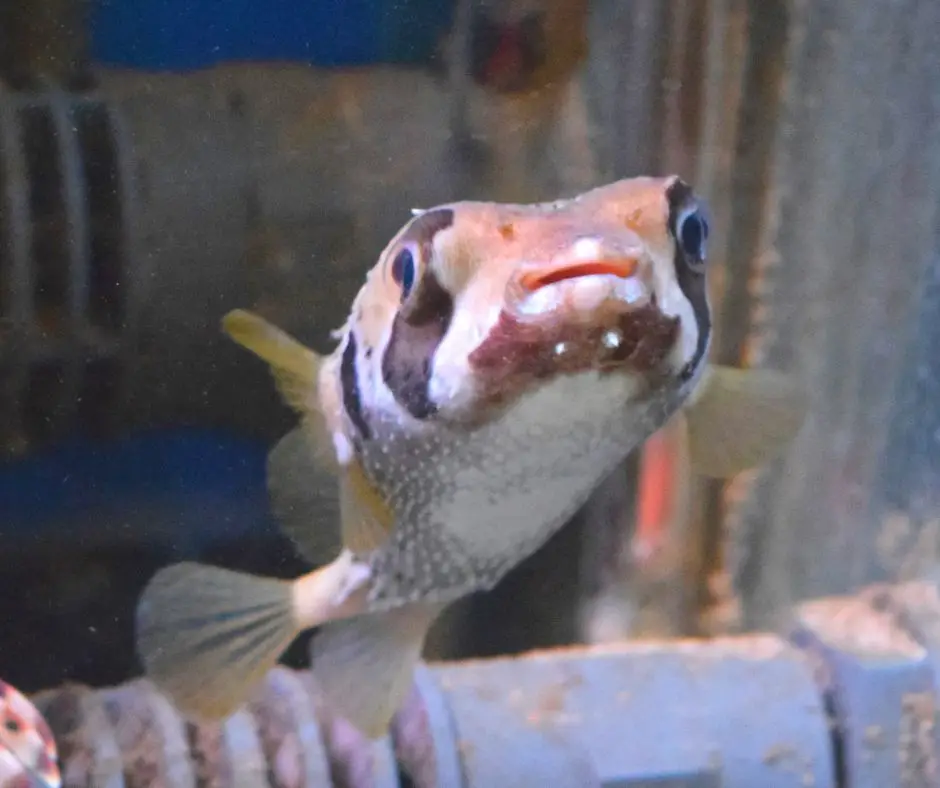
Generally, the ammonia intensities in a new tank can increase very fast because of the lack of constructive germs in the tank.
Your pufferfish may die if you keep them in this type of tank. Therefore, it is recommended to do a nitrogen cycle before you decide to introduce a fish to a new tank.
Parasitical
Pufferfish can die if parasites infest them for a long time.
Some parasites that can affect pufferfish are anchor worms, itch, black spots, Oodinium, Planarian, and external parasites. These parasites can harm both your pufferfish and their tankmates.
Therefore, you should be on the lookout for possible signs of parasite infection in pufferfish and treat them immediately.
Bacterial Infections
Another reason for the death of pufferfish is bacterial infections. Bacterial infections can lead to loss of appetite, abnormal growth, and death.
Some bacterial infections that can affect pufferfish are poped eye, fin rot, dropsy, hole-in-the-head, etc.
Pollutions
Water pollution can also lead to the death of pufferfish. Pufferfish require a specific water parameter to stay healthy, and pollution can lead to the buildup of ammonia and nitrite in the water.
This can then stress out your axolotl, causing health problems if not detected early.
Septicemia
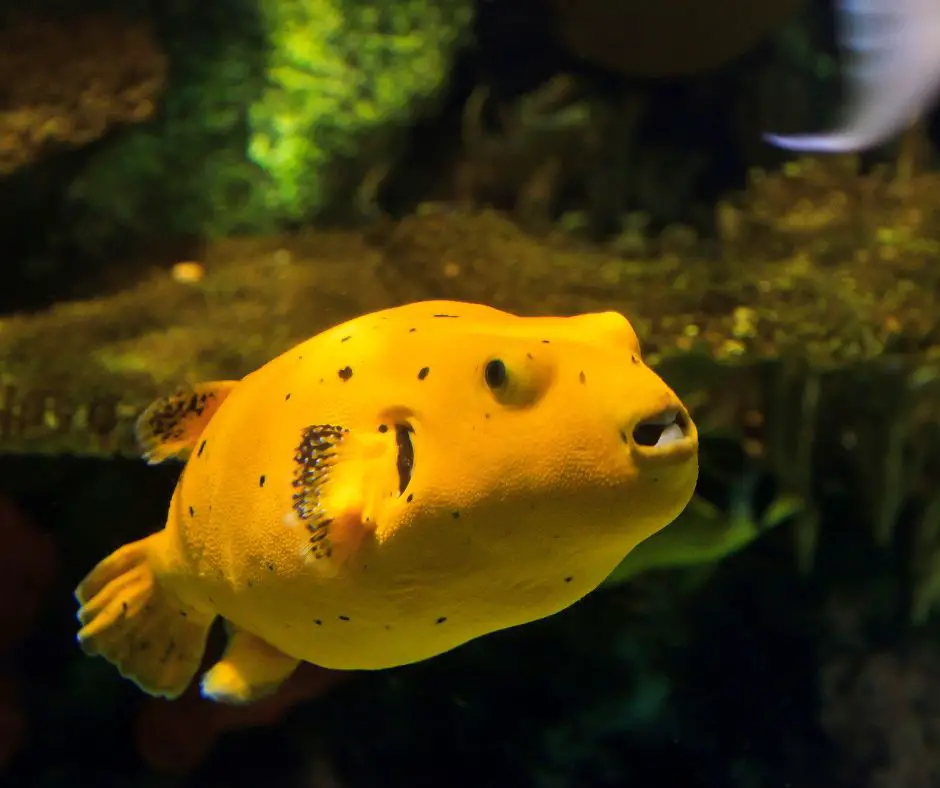
Pufferfish can also die from poison brought into the aquarium by another fish.
Some of the signs of septicemia in pufferfish are bulging eyes, gills that look bruised, open sores, distended abdomen, and hemorrhaging of the skin and inner organs.
There is no cure for septicemia, but you can help ease the pain until your pufferfish pass away by giving them an antibiotic.
Fungus
Fungus is another common cause of death in pufferfish.
Your pufferfish can be infested by fungus if the water quality in their tank is poor or there are several decomposing materials in the tank. The fungus can kill your fish if you don’t treat them.
How Do You Save a Puffer Fish From Dying
To save a pufferfish, you need to understand the root cause in order to treat it. If caught early, the disease is usually treatable. Remember, always prepare some good equipment for your pufferfish.
There are several ways to prevent your pufferfish from dying. Some of the best tips to prevent health problems in pufferfish are listed below.
- Test the water quality in their tank weekly
- Ensure the water has a pH balance of around 7.0-7.6 with a temperature around 74°-78°F
- Ensure the ammonia and nitrite level is 0 ppm.
- Ensure the nitrate level is below 20, while the nitrate level for dwarf puffers should be less than 10ppm.
- House your pufferfish in a tank with a low water current.
- Ensure the dKH is around 8-12
- Cycle the tank before you add new fish
- Change 25% of the water every week.
- Add live plants in their tank and create hiding spaces with lots of room to move around.
- Consult with your vet.
- Quarantine sick fish to help prevent spread.
- Ensure the filtration system in the tank is functional and at an optimal level.
- Pufferfish prefer to live alone, but you can opt for a larger tank to keep tank mates.
- Check and ensure your puffers are excreting waste regularly.
- Carefully follow the instructions when using any medication.
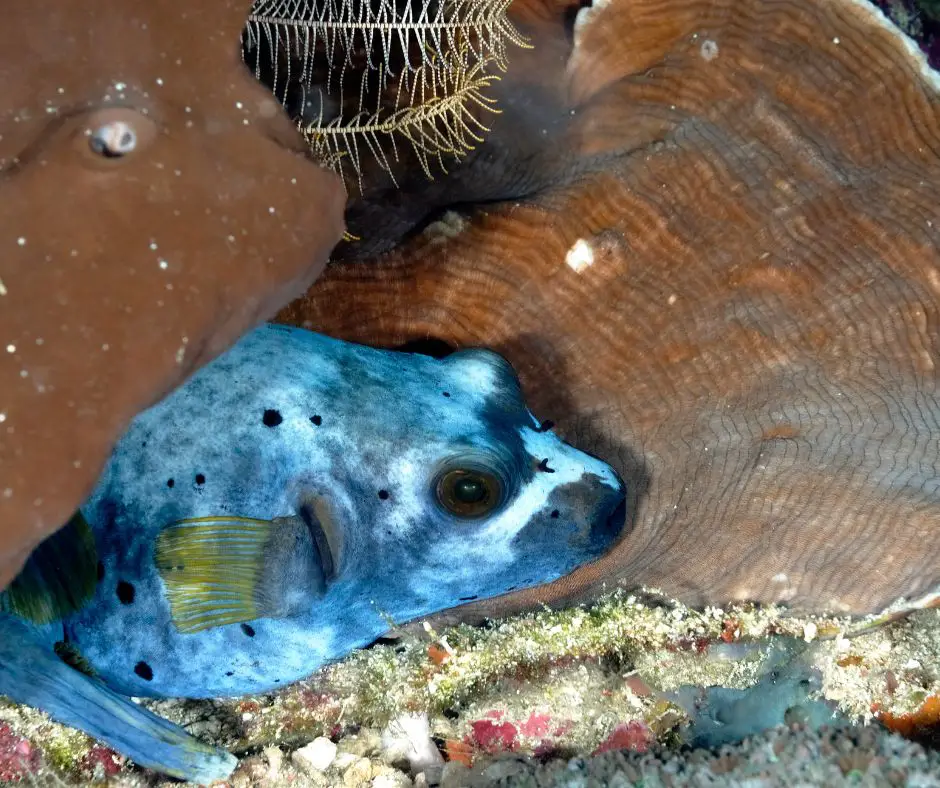
What Can You Do With a Dead Puffer Fish?
A dead pufferfish can cause damage to the entire water quality if not removed quickly. All the fish in the tank can easily contract health problems or even get stressed if protection is not taken.
However, it is not safe to touch pufferfish because they contain tetrodotoxin, a harmful chemical that is fatal to both humans and dogs if mistakenly ingested.
You can use a net to remove the dead fish from the tank, place it in at least two sealed plastic bags or containers, and then dispose of it in the garbage can.
PENN-PLAX Quick-Net Aquarium Fish Nets
- ESSENTIAL TOOL FOR FISHKEEPING: It’s always good to have an extra fish net for your aquarium! In addition to cleaning up some extra fish food that was accidentally poured, it becomes a handy tool when you need to quickly handle fish, and transfer them between tanks. They’re safe to use with both freshwater and saltwater fish, and come in various sizes!
- DURABLE, STRONG, AND SAFE: Each fish net features a vinyl covered, two-part braided handle that provides for an ergonomic grip, ensuring reliable operation with its strong design. Our aquarium fish nets won’t bend or become distorted over time, even with repetitive use. The mesh netting is appropriate for almost any type of aquarium fish, both freshwater and saltwater.
- MEASUREMENTS: The QN5 model of our Quick-Net line features a 5” x 4” net, with a handle length of 10”
- COLOR MAY VARY: Please be advised that our fish nets come in various shades of blue and green. We will ship based on availability. But rest assured, your fish won’t mind the difference in color, as long as they’re safely transported.
- SHOP PENN-PLAX FOR ALL YOUR PET’S NEEDS: PENN-PLAX is a manufacturer and distributor of top quality pet supplies, who specialize in creating excellent pet products for animals, both great and small.
Last update on 2022-12-29 / Affiliate links / Images from Amazon Product Advertising API
FAQs
How do you know when a fish is about to die?
Some of the signs that indicate that a pufferfish is about to die are: pufferfish is lethargic, lack of appetite, swollen gills, loss of pigmentation, pufferfish floats lethargically or hides frequently, swollen gills, sunken or cloudy eyes
Why is my pufferfish lying on the bottom?
It is quite normal for pufferfish to lay on the tank bottom as long as its belly is white. You will notice as your pufferfish will start swimming around after resting. You can give your pufferfish some minutes to get back to its active self.
How can you tell if a pufferfish is stressed?
As a rule, healthy Puffer will have a white, fat belly. They are also always curious and will explore the tank and look for food. If they often hide and puff up, it shows that they are scared and stressed.
Wrapping Up
Pufferfish are incredible and unique fish species that are kept as a pet. They are quite a hardy fish species and will stay active and healthy if you can provide good care.
A great way to ensure that your pufferfish is healthy is to detect any signs of health problems as early as possible.
